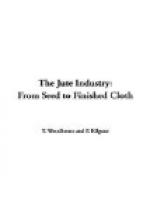The cuttings may be partially loosened by means of blows from a heavy iron bar; boiling water is then poured on the fibre, and then the material is built up with room left for expansion, and allowed to remain in this condition for a few days. A certain quantity of this material may then be used along with other marks of jute to form a batch suitable for the intended yarn.
A very common practice is to cut the hard root ends off by means of a large stationary knife. At other times, the thin ends of the stricks are also cut off by the same instrument. These two parts are severed when it is desired to utilize only the best part of the strick. The root ends are usually darker in colour than the remainder, and hence the above process is one of selection with the object of securing a yarn which will be uniform in colour and in strength.
CHAPTER VII. CARDING
Breaker and Finisher Cards. After the fibre from the softening machine has been conditioned for the desired time, it is ready for one of the most important processes in the cycle of jute manufacture; this process is termed carding, and is conducted in two distinct types of machines—
1.
The breaker card.
2.
The finisher card.
The functions of the two machines are almost identical; indeed, one might say that the work of carding should be looked upon as one continuous operation.
The main difference between the two types of machines is in the method of feeding, and the degree of fineness or setting of the small tools or pins which perform the work. In both cases the action on the stricks of jute is equivalent to a combined combing and splitting movement, and the pins in the various rollers move relatively to each other so that while the pins of a slowly-moving roller allow the strick or stricks (because there are several side by side) to pass slowly and gradually from end to end, the pins of another but quickly-moving roller perform the splitting and the combing of the fibre. The pins of the slowly-moving roller hold, so to speak, the strick, while the pins of the quickly-moving roller comb out the fibres and split adhering parts asunder so as to make a comparatively fine division.
The conditioned stricks from the softening machine are first arranged in some suitable receptacle and within easy reach of the operative at the back or feed side of the breaker card. A receptacle, very similar to that used at the breaker card, appears near the far end of the softening machine in Fig. 13.
A modern breaker card is illustrated in Fig. 14. The feed or back of the card is on the extreme right, the delivery or front of the card on the extreme left, while the gear side of the card is facing the observer. The protecting cages were removed so that the wheels would be seen as clearly as possible.




